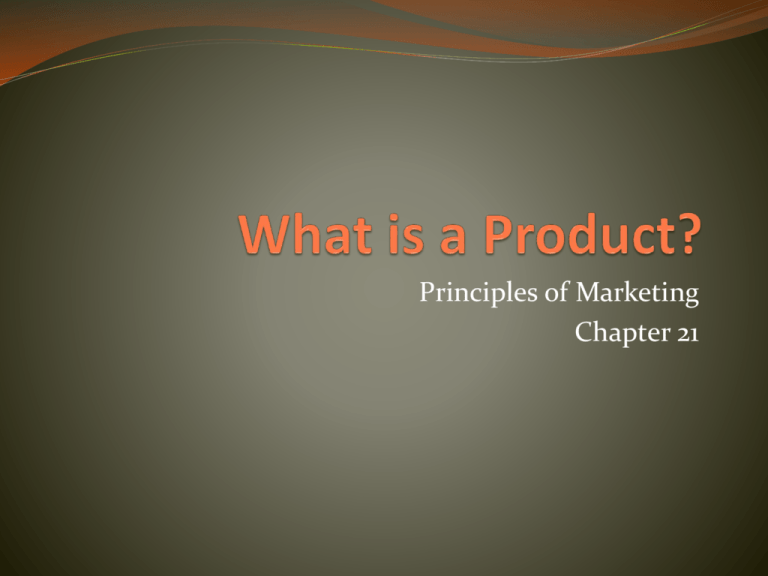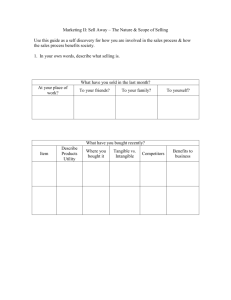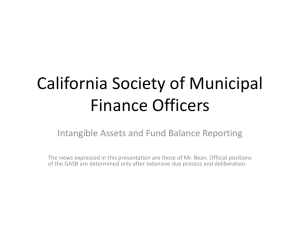What is a Product?
advertisement

Principles of Marketing Chapter 21 The Marketing Mix Product is the primary P of the marketing mix The other marketing mix decisions are based on the product decision If you don’t have a product to sell, you won’t need a place, price or promotion Types of Products Three main categories Good Service Idea Goods are also called tangible, an item that exists physically and can be touched (i.e. cell phone, toothpaste) Intangible is something that exists but is not physical and cannot be touched (i.e. cell service, manicure) Services and ideas are intangible i.e. haircut, “buckle up” Give three examples for each of the three main categories (unique examples) identify each of your products as tangible(T) or intangible (I) and explain how each one is either tangible or intangible Two Groups of Products Consumer products Sold to customers for personal use Business products Products sold to businesses for business use Business use includes: Making new products Buying products for resale Buying products for use in running the business Give three examples of customer products and three examples of business products and explain how if fits in that category. The Service Economy An economy in which most of the GDP comes form services and most of the workers have jobs in services Click on the following link to read about the service economy in the US http://minnesota.publicradio.org/display/web/2012/03 /29/daily-circuit-service-economy Study the graphic on the following website and explain the trend of service business in the US economy http://www.ritholtz.com/blog/2012/01/the-shift-frommanufacturing-to-service-economy/ Critical Thinking Why do you think the United States economy turned into a service economy? Does this mean our economy is not as successful? Why or why not? List at least ten services that you use. Characteristics of Services Intangible—no physical characteristics, cannot be touched before purchase Concert tickets are intangible, you cannot try it out beforehand Marketers find it difficult to advertise an intangible product Insurance is an example of an intangible product Look up the Allstate Insurance slogan and explain how their logo image makes the intangible service of insurance seem like something more visible Answer the questions Can you think of other symbols besides Allstate that tries to give you a visual image of an intangible service? Make a list of services that you rely on each week and discuss them. Who provides the services? What do you pay for them? Could you do with out any of them? Are some services provided by the government? Characteristics of Services Inseparable—production of the service cannot be separated from use of the service A haircut does not exist without the hairdresser A haircut does not exist until the hairdresser cuts your hair Variable—produced and consumed at the same time The service is always unique Can never be exactly replicated in the same way Problems with variability Quality control—each customer gets the same quality? This is why certification/licenses are needed Effective personnel training and careful monitoring of customer satisfaction and feedback can help maintain high standards Characteristics of Services Perishable—product cannot be stored for later use Milk and seafood Services cannot be stored for later use Unsold concert tickets Barber has no customers for one hour Barber cannot save that time for a later time when the shop is crowded with customers Marketers must analyze the intangible, inseparable, variable and perishable attributes of the service Overcoming Service Obstacles The Good-Service Continuum Some businesses provide a combination of good and service (i.e. restaurant) Restaurants provide a good: food Restaurants provide a service: atmosphere, preparation of food, and presentation Use the Good-Service Continuum handout to create your own. Label the diagram with pure goods, pure services and combinations in between Products Basic product—determine what you will sell Skateboards Refrigerators Auto repair (service) Child care (service) Candidate for office (idea) Fund-raiser for charity Product Elements, cont. Basic Product Quality Features Options Usage Instructions Installation Technical support Protection Packaging Warranty Maintenance and repair services Name Product name Brand name Personality Activity Choose one of the following products DVD Car Cell phone TV Toaster List the basic product elements you would want in the product Discuss the concept of the basic product elements Quality Quality is the level of excellence in something Premium-highest quality materials; highest price Moderate-middle range of quality; good quality materials; moderate price Value-adequate level of quality; lowest price with the best possible quality at that price Features Both goods and services have features Tangible good The physical characteristic of the good Service One of the tasks that will be done as part of the service Example Physical features of a cell phone Size and color Service features of a cell phone Voice mail and call waiting Activity Using your lists created from the previous activity, form a group with three others who picked the same product. In your group, decide on the brands of the product that would fit in each of the three quality levels. Share you decision with the class. Options Option is a feature that can be added to a product Many products are designed as a basic product, with features that can be added Options are sometimes called optional features Example: options on an automobile might include sunroof, leather seats, and 6-disc CD player Options enable the customer to customize the product to his or her specific needs and wants Usage Many products are designed to be assembled, installed, or used in some way Part of the product decision is how to help the customer make the best use of the product Frustrated or dissatisfied customers may return the product or just never buy from you again Aspects of Usage Instructions—a sheet of assembly instructions, user’s guide or instruction manual Products that require instructions include: furniture, electronic devices, software Installation—the process of placing a good where it will be used and making the good ready for use Products that require installation include: appliances, carpeting, plumbing fixtures, and in-car stereo systems Some customers perform their own installations, others want an expert to install goods for them Aspects of Usage, con’t. Technical support—consists of people who are available to help customers with problems Complex consumer products that need support include: software, electronic devices, and Internet service Complex business products include: factory equipment, telecommunications systems Discuss your personal experience with a product that required one of the usage aspects discussed and explain how you used that support for your purchase. Protection Grades and Standards—measurable attributes that describe the value and utility of a product On butter or eggs look for “USDA Grade A” symbol Safety standards for automobiles Marketers often promote these attributes to impact customer-buying decisions Packaging—protecting the product from damage until the customer is ready to use it. Packaging may keep food fresh Protect fragile products such as computers Packaging, con’t. Promotion—packaging is often discussed as part of the promotion decision as well as the product decision Often the “face” of the product Cereal boxes Easier to stack of display in retail stores Can be designed to protect the consumer Plastic bottles instead of glass, child safety caps for meds Can provide information about the product, such as content labeling, nutritional information and weight Used for services and ideas The image and décor of an office are the only tangible features of a service Warranties Customers worry about an expensive item lasting Warranty is a written document stating the quality of a product and promising to correct specific problems that may occur New automobiles have a warranty—promises for a certain amount of time or miles the manufacturer will replace or repair specific parts if they break Guarantee is a promise that a product has a certain quality or will provide satisfaction Pizza delivery guaranteed in 30 minutes or its free Guarantee is usually used in promotions whereas a warranty is a written document Maintenance and Repair Services Many complex machines, especially for the business market, require regular maintenance Automobile dealerships always have a maintenance department Consumers often choose to buy from the dealer with the most convenient service department Name Product name Brand name Product’s personality Choosing the right name can guide the product decision Name can guide product and other marketing mix decisions Product Strategy Consists of all the decision made about the product Which product to offer Various elements of the product Made with the target market in mind Strategies developed to distinguish your product from the competition’s products Balance meeting customer needs and beating the competition with the costs of producing and marketing Must also be coordinated with the strategies for the other Ps








